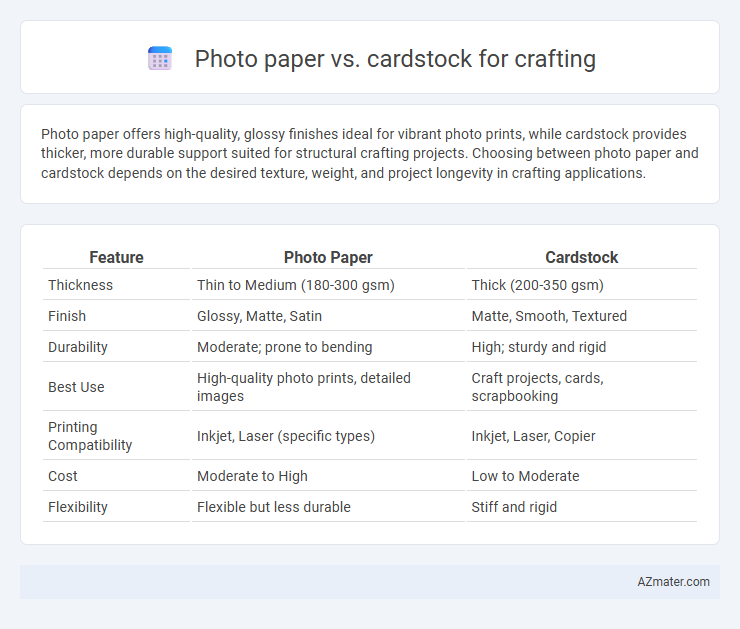Photo paper offers high-quality, glossy finishes ideal for vibrant photo prints, while cardstock provides thicker, more durable support suited for structural crafting projects. Choosing between photo paper and cardstock depends on the desired texture, weight, and project longevity in crafting applications.
Table of Comparison
| Feature | Photo Paper | Cardstock |
|---|---|---|
| Thickness | Thin to Medium (180-300 gsm) | Thick (200-350 gsm) |
| Finish | Glossy, Matte, Satin | Matte, Smooth, Textured |
| Durability | Moderate; prone to bending | High; sturdy and rigid |
| Best Use | High-quality photo prints, detailed images | Craft projects, cards, scrapbooking |
| Printing Compatibility | Inkjet, Laser (specific types) | Inkjet, Laser, Copier |
| Cost | Moderate to High | Low to Moderate |
| Flexibility | Flexible but less durable | Stiff and rigid |
Understanding Photo Paper and Cardstock
Photo paper features a glossy or matte finish designed to enhance image quality and color vibrancy, making it ideal for printing high-resolution photographs. Cardstock, characterized by its thicker, more durable texture, provides structural support for crafting projects such as scrapbooking, card making, and paper models. Understanding the material properties, thickness (measured in GSM), and surface finish of each helps crafters choose the optimal medium for their specific artistic and functional needs.
Key Differences Between Photo Paper and Cardstock
Photo paper offers a glossy or matte finish designed specifically for high-resolution image printing, providing vibrant color reproduction and smooth texture. Cardstock is thicker, sturdier, and more rigid, making it ideal for physical crafts requiring durability, such as greeting cards or invitations. The primary difference lies in their composition and purpose: photo paper emphasizes image quality, while cardstock prioritizes structural strength and versatility in crafting.
Durability: Which Material Lasts Longer?
Photo paper typically offers a glossy finish that enhances color vibrancy but is more prone to scratching and fading over time compared to cardstock. Cardstock's thicker, heavier composition provides superior durability, resisting bending, tearing, and moisture damage, making it ideal for long-lasting crafting projects. For crafts requiring longevity and sturdy handling, cardstock generally outperforms photo paper in terms of material durability.
Print Quality: Vibrancy and Detail Comparison
Photo paper delivers superior print quality with exceptional vibrancy and sharp detail due to its smooth, coated surface designed to absorb ink precisely, making colors pop and images appear crisp. Cardstock, being thicker and more porous, offers a matte or semi-gloss finish that can slightly absorb ink, often resulting in less vivid colors and softer edges. For projects where high-resolution images and bright color reproduction are crucial, photo paper outperforms cardstock in achieving professional-grade prints.
Texture and Finish Options
Photo paper offers a smooth, glossy finish that enhances vibrant colors and sharp details, ideal for high-quality photo prints in crafting projects. Cardstock provides a thicker, more rigid texture with a matte or satin finish, making it suitable for creating durable cards, scrapbooking, and layered designs. Choosing between photo paper and cardstock depends on whether a sleek, glossy look or a sturdy, tactile surface better fits the project's aesthetic and functional needs.
Best Uses for Photo Paper in Crafts
Photo paper excels in crafting projects requiring vibrant, high-resolution images such as custom photo prints, scrapbooking, and personalized greeting cards. Its glossy or matte finishes enhance color depth and detail, making it ideal for photo-based crafts and decorative accents. Lightweight and compatible with most inkjet printers, photo paper ensures crisp, professional-looking results for creative projects emphasizing visual appeal.
Best Uses for Cardstock in Crafts
Cardstock is ideal for crafting projects that require durability and structure, such as scrapbooking, handmade cards, and paper models. Its thicker and more rigid texture provides excellent support for embellishments, stamping, and intricate cutting. Unlike photo paper, cardstock holds up well under glue and paint, making it perfect for multi-dimensional craft designs and DIY decorations.
Cost-Effectiveness for Large Projects
Photo paper offers vibrant color reproduction but tends to be more expensive per sheet compared to cardstock, making cardstock a more cost-effective option for large crafting projects. Cardstock provides durability and a sturdy base at a lower price point, which helps reduce overall expenses when purchasing in bulk. For extensive crafting needs, choosing cardstock balances quality and affordability, optimizing budget management without compromising project scale.
Compatibility with Printers and Cutting Machines
Photo paper is designed for high-quality ink absorption, making it compatible with most inkjet printers but less suitable for heavy-duty cutting machines due to its thinner and more delicate nature. Cardstock offers greater thickness and rigidity, ensuring excellent compatibility with laser printers and robust cutting machines like Cricut and Silhouette, which handle its sturdiness without tearing. Choosing cardstock enhances precision in intricate cuts, while photo paper excels in producing vibrant, glossy images for crafting projects requiring detailed printing.
Choosing the Right Material for Your Crafting Needs
Photo paper offers a glossy or matte finish ideal for vibrant, detailed images and professional-quality prints, making it perfect for photo-based crafts. Cardstock provides a thicker, more durable surface suitable for structural projects like cards, scrapbooking, and paper models. Selecting between photo paper and cardstock depends on whether you prioritize image clarity or material strength for your crafting goals.

Infographic: Photo paper vs Cardstock for Crafting
 azmater.com
azmater.com